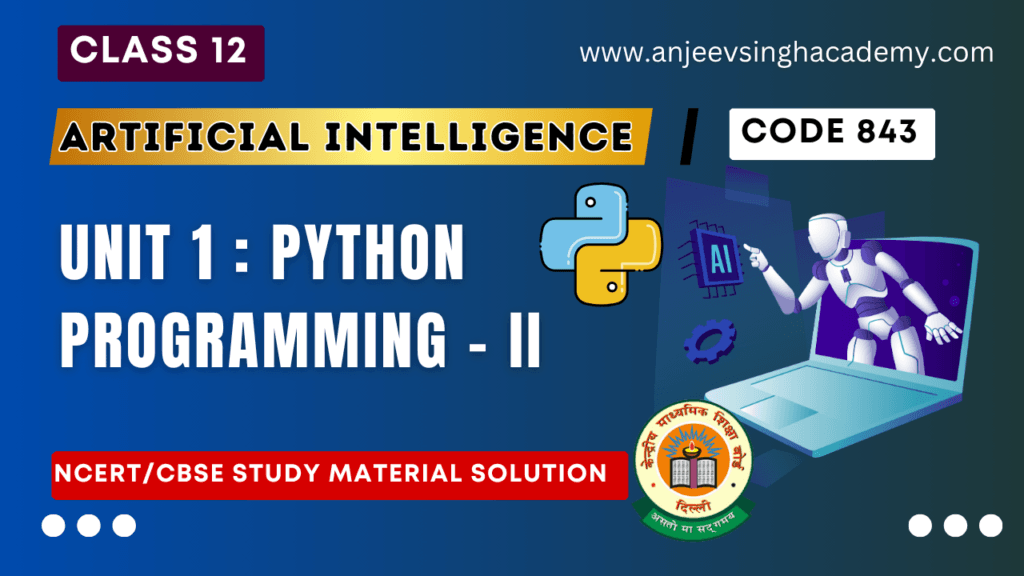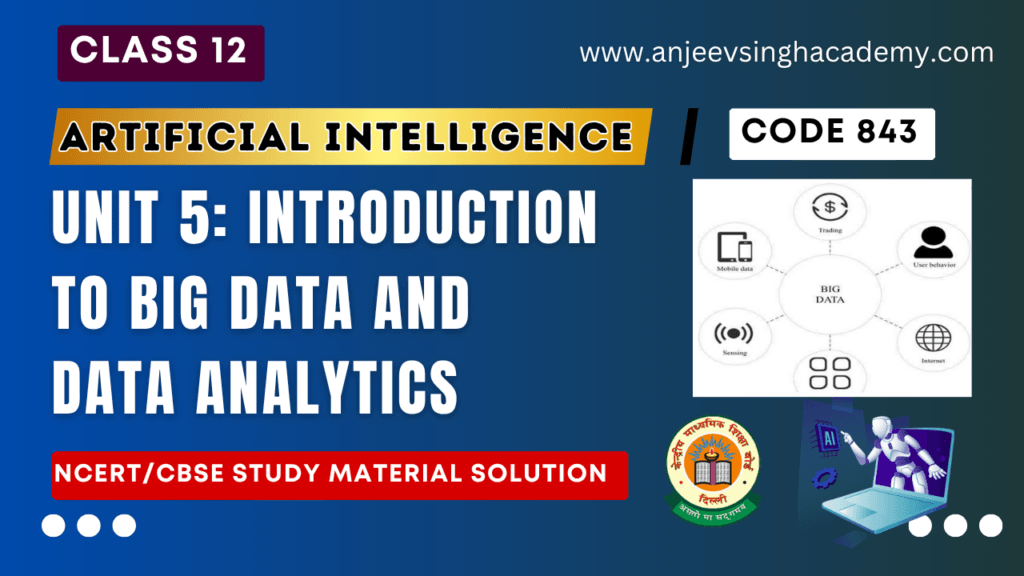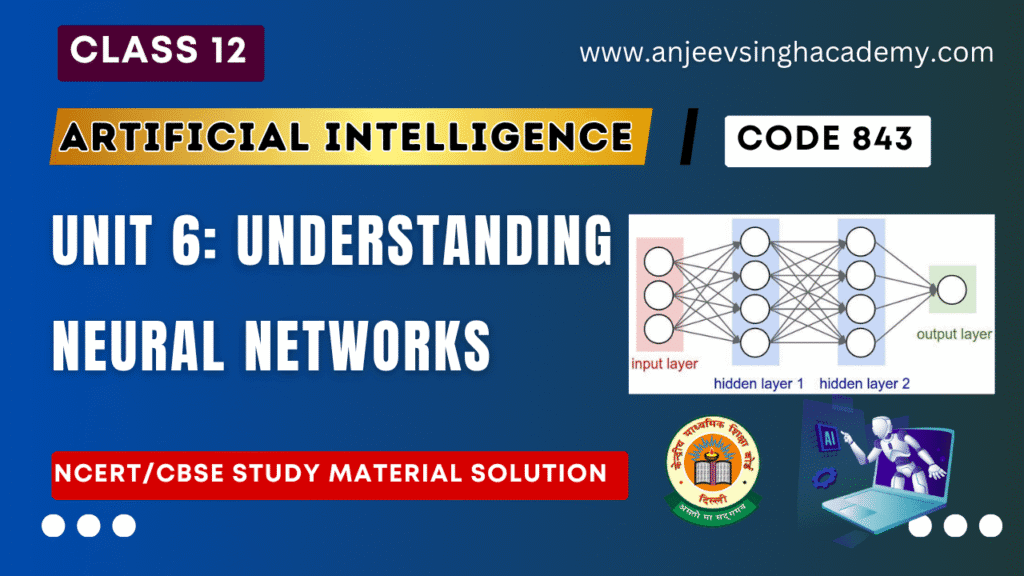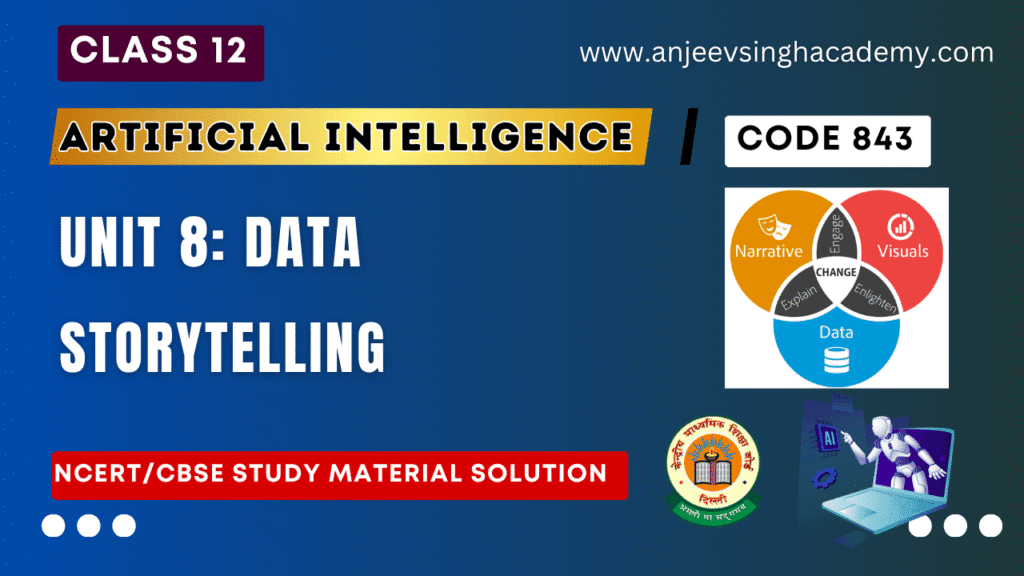Class 12 AI Unit 7 Generative AI Book Solution
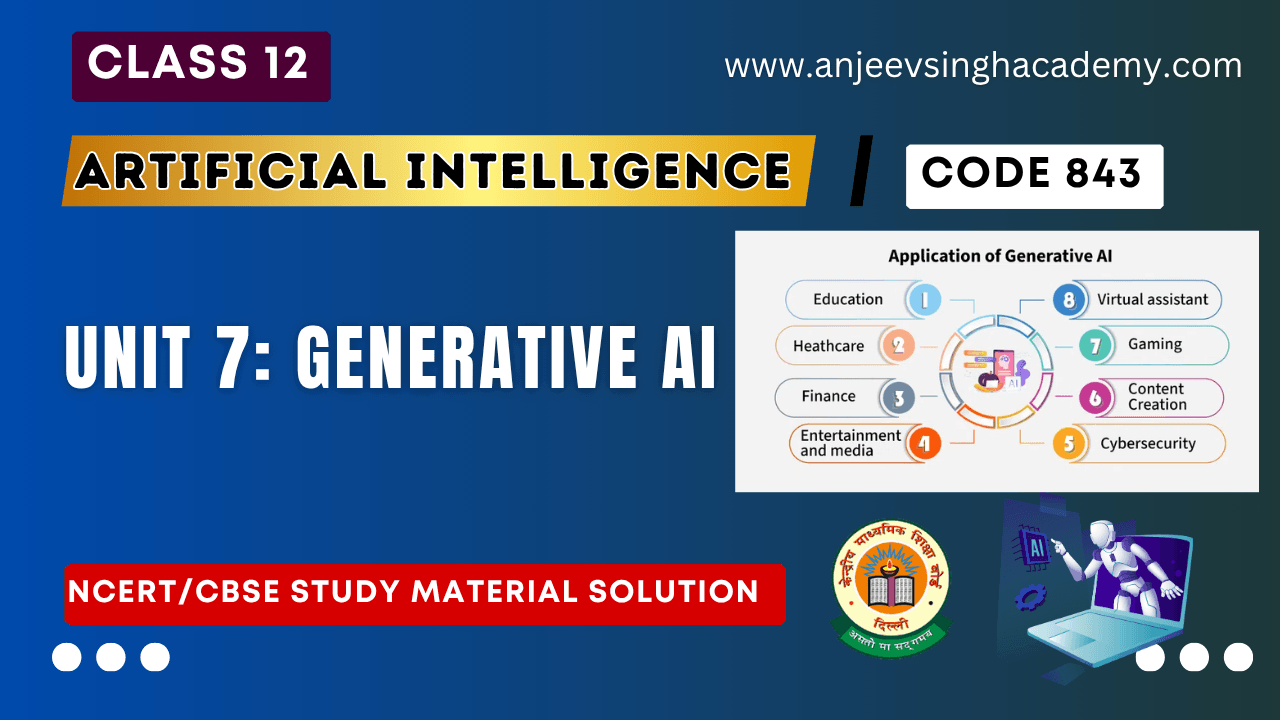
A. Multiple Choice / Objective Type Questions
- What is the primary objective of generative AI?
a) To classify data into different categories
b) To generate new data resembling its training samples
c) To learn from labelled data for decision-making
d) To predict outcomes based on input features
Ans: b. To generate new data resembling its training samples
- Which machine learning algorithms are commonly used in generative AI?
a) Support Vector Machines (SVM)
b) Decision Trees
c) Generative Adversarial Networks (GANs) and Variational Autoencoders (VAEs)
d) Random Forests
Ans: c) Generative Adversarial Networks (GANs) and Variational Autoencoders (VAEs)
- What is the purpose of generative AI in text generation?
a) To create coherent and contextually relevant text based on given prompts
b) To identify patterns in text data for classification tasks
c) To analyse sentiment in social media posts
d) To generate code from natural language inputs
Ans: b) To identify patterns in text data for classification tasks
- Which generative AI model is known for its application in text generation?
a) Meta AI’s Voicebox b) Google’s Lumiere
c) OpenAI’s ChatGPT d) Stability AI
Ans: c) OpenAI’s ChatGPT
5. In image generation, what analogy describes how generative AI models work?
a) Computers analyse sounds to produce new images.
b) Computers make new pictures based on existing ones, resembling patterns they have learned.
c) Computers generate images by understanding class boundaries in data.
d) Computers utilise labelled data to predict outcomes.
Ans: b) Computers make new pictures based on existing ones, resembling patterns they have learned.
6. Which of the following is NOT an application of generative AI?
a) Creating original music compositions
b) Crafting promotional videos for marketing campaigns
c) Analysing sentiment in social media posts
d) Identifying features in image datasets
Ans: c) Analysing sentiment in social media posts
7. What distinguishes generative models from discriminative models in terms of their training focus?
a) Generative models learn to generate new data, while discriminative models focus on identifying class boundaries.
b) Generative models focus on learning to draw lines to separate data, while discriminative models analyse the sentiment in text data.
c) Generative models learn to understand the underlying data distribution, while discriminative models analyse patterns in data.
d) Generative models aim to identify different classes in data, while discriminative models focus on generating new data samples.
Ans: a) Generative models learn to generate new data, while discriminative models focus on identifying class boundaries.
8. Which technology raises concerns about the authenticity of digital content and the spread of misinformation?
a) Deepfake AI b) Generative Adversarial Networks (GANs)
c) Variational Autoencoders (VAEs) d) Convolutional Neural Networks (CNNs)
Ans: a) Deepfake AI
B. True / False
1. Generative AI can only generate text and images, not audio or video.
Ans: False
2. Generative Adversarial Networks (GANs) involve competition between the Generator and the Discriminator networks.
Ans: True
3. Discriminative models generate new data samples similar to the training data.
Ans: False
4. Variational Autoencoders (VAEs) are AI generative models that can be used for tasks such as image generation.
Ans: True
5. Deepfake technology is an application of generative AI that can create realistic fake videos.
Ans: False
6. Large Language Models (LLMs) like GPT and BERT cannot generate human-like text.
Ans: False
C. Fill in the blanks
1. Generative AI utilises _____ learning algorithms to learn from existing datasets.
Ans: training
2. Examples of Generative AI include ChatGPT, DALL-E, Gemini, and _____.
Ans: Claude
3. The full form of GAN is_______.
Ans: Generative Adversarial Networks
4. ____ Generation is an application of Generative AI where computers create new images that resemble the ones they have seen before.
Ans: Image
5. OpenAI’s ChatGPT and Google’s Bard (Gemini) are examples of Generative AI used for ____ Generation.
Ans: Text
6. _____, like GPT models developed by OpenAI, are trained on vast amounts of text data to understand and generate human-like text.
Ans: Large Language Models (LLMs)
D. Short Answer Questions
1. What is Generative AI?
Ans- Generative AI is a facet of artificial intelligence that creates new content resembling its training samples, including text, images, audio, and video.
2. How does Generative AI work?
Ans- It learns patterns from existing datasets using machine learning algorithms and intense learning to generate similar new samples autonomously.
3. What distinguishes generative models from discriminative models?
Ans- Generative models aim to understand and replicate the underlying data distribution to generate new samples, while discriminative models focus on distinguishing between different data classes.
4. Give examples of Generative AI applications.
Ans – Examples include ChatGPT for text generation, DALL-E for image generation, and Google’s Music LM for audio generation
5. What are Generative Adversarial Networks (GANs)?
Ans- GANs are a class of AI algorithms used in Generative AI for tasks like image generation, where two networks, a generator and a discriminator, work against each other to improve the quality of generated images.
6. What is a Large Language Model (LLM)?
Ans– LLMs are sophisticated AI models trained on vast text data to understand and generate human-like text, excelling in natural language processing tasks.
7. How is Generative AI used in image generation?
Ans – Generative models learn to reproduce the data distribution, while discriminative models learn to separate classes within the data based on features.
8. What ethical considerations surround Generative AI?
Ans – Analysing patterns from input images and generating new images with similar features, like creating new cat images from observed ones.
9. What are the limitations and risks involved with Large Language Models?
Ans– Limitations include high computational costs, the potential for generating incorrect information, and data privacy concerns.
E. Case Study Analysis
Scenario:
A marketing agency, “Creative Horizons”, leverage Generative AI technologies to enhance its campaign strategies. The agency uses various AI models for creating unique advertising content, including AI-generated images, personalised text for email campaigns, dynamic video ads, and innovative audio jingles. One of their key projects involves launching a new line of eco friendly products for a client. The campaign’s success hinges on the uniqueness and engagement of the generated content, aiming to highlight the product’s sustainability features innovatively.
- What are the primary types of AI models used by “Creative Horizons” for their campaign?
Ans– Generative AI models, including image and text generation models, video generation algorithms, and audio synthesis tools.
- How does Generative AI contribute to creating personalised email campaign content?
Ans– Generative AI analyses customer data and previous engagement metrics to produce personalised text that resonates with each segment of the agency’s target audience, improving engagement and response rates.
- Identify one potential ethical consideration the agency must address when using Generative AI in advertising.
Ans– The agency must ensure that the AI-generated content does not inadvertently propagate biases or stereotypes, maintaining ethical standards in representation and messaging.
- What is a significant advantage of using Generative AI for dynamic video ad creation?
Ans– Generative AI can rapidly produce diverse and innovative video content tailored to different platforms and audience preferences, significantly reducing production time and costs while enhancing creativity.
- How can “Creative Horizons” ensure their AI-generated content’s originality and copyright compliance?
Ans– The agency should implement checks to verify the uniqueness of the content, use AI models trained on copyright-compliant datasets, and provide proper attribution or licenses for AI-generated outputs, ensuring compliance with copyright laws and ethical guidelines.
F. Ethical Dilemma
Read the following ethical dilemma and provide your response:
Ethical Dilemma Scenario:
An AI development company, “InnovateAI,” has created a new Generative AI model that can produce original music tracks by learning from a vast database of songs across various genres. The AI’s capability to generate music that rivals compositions by human artists has attracted significant attention in the music industry. However, “InnovateAI” faces an ethical dilemma: the AI model inadvertently replicates distinctive styles and melodies of existing copyrighted works, raising concerns about copyright infringement and the originality of AI generated music. Furthermore, the company discovered that some AI-generated tracks contain elements remarkably similar to unreleased songs by living artists, likely due to including these tracks in the training data without consent.
Discussion Question:
Should “InnovateAI” release this music-generating AI to the public, considering the potential for copyright infringement and ethical concerns regarding the originality of AI-generated content? What measures should be taken to address these ethical and legal issues while advancing technological innovation in the music industry?
Response:
“InnovateAI” faces a complex situation that balances the fine line between innovation and ethical responsibility. Before releasing the AI model to the public, the company should take several steps to mitigate potential legal and ethical issues:
- Transparency: “InnovateAI” should be transparent about the AI’s capabilities and limitations, including the potential for generating content that may resemble existing copyrighted works. This transparency should extend to how the model was trained, including the sources of its training data.
- Consent and Copyright Compliance: The company must ensure that all data used to train the AI model is either in the public domain, copyrighted with permission, or used under 184 fair use provisions. This may involve auditing the training dataset to remove any copyrighted material included without consent.
- Creative Attribution: “InnovateAI” should consider implementing a system for attributing the creative influences of AI-generated music. This could involve tagging AI generated tracks with metadata referencing the styles or artists that influenced the AI’s composition, indirectly acknowledging human artists’ contributions.
- User Guidelines: Providing clear guidelines regarding the ethical use of AI-generated music, including advising against passing off AI-generated compositions as entirely original works without acknowledging the AI’s role.
- Technological Solutions: Developing and integrating technology that can detect and flag potential copyright issues in AI-generated compositions before making them public. This tool could help identify elements too closely resembling existing copyrighted works, allowing for revision or alteration.
- Engaging with Stakeholders: “InnovateAI” should engage in dialogue with copyright holders, artists, and legal experts to explore collaborative solutions that respect copyright while fostering innovation. This could include licensing agreements or partnerships with music publishers.
By taking these measures, “InnovateAI” can address ethical concerns head-on while contributing positively to the music industry. It acknowledges the importance of balancing innovation with respect for existing creative works and copyright laws, ensuring that advancements in AI benefit all stakeholders in the music ecosystem. Note to Teachers: Teachers to discuss any other ethical concern.
G. Competency Based Questions
- Anita works for a social media company that is exploring the use of Generative Adversarial Networks (GANs) to generate personalized content for its users. However, there are concerns about the ethical implications of using AI to manipulate users’ perceptions and behaviours. What are some potential ethical concerns associated with using GANs to generate personalized content on social media platforms?
Ans– Some potential ethical concerns include:
- Manipulation of user perceptions potentially leading to misinformation or exploitation.
- Invasion of privacy
- Amplification of biases leading to unfair treatment or discrimination.
- A research team is using Generative AI to generate synthetic data for training medical imaging algorithms to detect rare diseases. However, there are concerns about the potential biases and inaccuracies in the generated data. What steps can the research team take to mitigate biases and ensure the accuracy and reliability of the synthetic data generated by Generative AI for medical imaging applications?
Ans- The research team can take the following steps:
- Ensure that the training data used to train the Generative AI model represent a diverse range of demographics, including underrepresented groups, to mitigate biases.
- Validate the synthetic data generated by the model against real medical imaging data to ensure accuracy and reliability.
- Involve domain experts, such as medical professionals and imaging specialists
- Continuously refine and improve the Generative AI model based on feedback from domain experts and the performance of the medical imaging algorithms trained on the synthetic data.
- A music streaming platform is considering using Generative AI to create personalized playlists for users based on their listening habits. They want to ensure that the generated playlists accurately reflect users’ preferences and introduce them to new music they might enjoy. How can the music streaming platform ensure that the playlists generated by Generative AI effectively cater to users’ preferences while also introducing them to new music?
Ans– The music streaming platform can:
- Analyze user listening habits to inform playlist generation.
- Introduce randomness to expose users to new music aligned with preferences.
- An interior design company wants to use Generative AI to create room renderings for client presentations. They aim to ensure that the generated designs are both attractive and practical. How can the interior design company ensure that the room renderings generated by Generative AI are both visually appealing and functional?
Ans– The interior design company can:
- Curate diverse room design data for training.
- Incorporate design principles into the Generative AI model.
- Seek feedback from experienced interior designers.
- A marketing agency needs visually appealing social media posts for an advertising campaign. How can the marketing agency use Generative AI to create diverse and engaging visuals for their campaign?
Ans– The marketing agency can:
- Collect relevant images for training the Generative AI model.
- Generate visuals aligned with the campaign’s branding.
- Review and refine the generated visuals for maximum impact.

